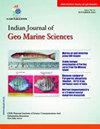Bacterial and archaeal communities in near-surface marine sediments from İzmir Bay (Eastern Aegean Sea), using Quantitative PCR
IF 0.5
4区 地球科学
Q4 Earth and Planetary Sciences
引用次数: 0
Abstract
Marine sediments are good sources of both subsistent and anthropogenic ingredients. Recently, an assessment of phylogenetic analysis at the genotypic and molecular levels has revealed the phylogenetic relationships of the prokaryotes. In our study, samples were collected from the surface of sediments in the İ zmir Bay, located in the eastern Aegean Sea and surrounded by the coastal city of İ zmir. Total genomic DNA was extracted from 0.25 g sediment of each sample and used in real-time qPCR to detect 16S rDNA genes of archaea, bacteria, sulfate-reducing bacteria, Desulfobulbus , and Desulfosarcina - Desulfococcus . Our results showed that the maximum number of all samples was found in bacterial primers (1.24×10 9 DNA copy numbers/g), while the minimum number was observed in Desulfosarcina-Desulfococcus primers (1.17×10 2 DNA copy numbers/g). Consequently, genetic studies should focus on investigating the abundance levels of seasonal and annual microbial groups in future studies. analyzed by real-time PCR were identified as a comparative This study was conducted in shallow and deeply buried sediments, and real-time qPCR was used to quantify various groups of microbial primers. Copy number of 16S rRNA gene for prokaryotes, bacteria, Geobacteraceae and sulfate-reducing prokaryotes (dissimilatory (bi)sulfite reductase gene - dsrA) was also investigated. This study shows that the number of all genes in the sediment decreased with increasing depth. The gene numbers of prokaryotes and bacteria showed similar results with a maximum of 10 8 – 10 10 cm -3 gene copies in shallow sediments. The number of copies of the genes of Geobacteraceae and the sulfate-reducing prokaryotes was 10 6 – 10 8 cm -3 gene copies in the sediments. Unlike the present study, Schippers and Neretin 19 examined sulfate-reducing bacteria and common bacteria according to different genes, besides the abundance of Geobacteraceae and prokaryotes. The results of our study were similar in the number of DNA copies of sulfate-reducing bacteria and common bacteria 19 . q-PCR analysis was performed by Einen et al. 40 to quantify and detect archaea and bacteria existing in the glass shell of seabed basalts of different ages and water depths. Results of this study showed that the total number of cells present in the basalt ranged from 6×10 5 to 4×10 6 cells per gram of basalt glass. The samples were taken from different ages and water depths, however, no significant differences were found in the concentrations or relative abundance of archaea and bacteria. In contrast to our study, Einen et al. 40 with common primers for archaea and bacteria, and the study was based on the number of microbes on the surface of basalts. The study in the ofİzmir湾(东爱琴海)近表层海洋沉积物中细菌和古细菌群落的定量PCR分析
海洋沉积物是生物成分和人为成分的良好来源。近年来,基因型和分子水平的系统发育分析揭示了原核生物的系统发育关系。在我们的研究中,样本是从位于爱琴海东部、被沿海城市İ兹米尔包围的İ兹米尔湾的沉积物表面收集的。从每个样品0.25 g沉积物中提取总基因组DNA,采用实时荧光定量pcr检测古菌、细菌、硫酸盐还原菌、Desulfobulbus和Desulfosarcina - Desulfococcus的16S rDNA基因。结果表明,所有样品中细菌引物的DNA拷贝数最多(1.24×10 9个/g),而Desulfosarcina-Desulfococcus引物的DNA拷贝数最少(1.17×10 2个/g)。因此,在未来的研究中,遗传研究应侧重于调查季节性和年度微生物群的丰度水平。本研究分别在浅埋和深埋沉积物中进行,采用real-time qPCR对各组微生物引物进行定量分析。研究了16S rRNA基因在原核生物、细菌、土细菌科和硫酸盐还原原核生物中的拷贝数(dissimilatory (bi)亚硫酸盐还原酶基因- dsrA)。该研究表明,沉积物中所有基因的数量随深度的增加而减少。浅层沉积物中原核生物和细菌的基因拷贝数相似,最多为10个8 ~ 10个10 cm -3基因拷贝。土杆菌科和硫酸盐还原原核生物的基因拷贝数为10个6 ~ 10个8 cm -3基因拷贝。与本研究不同的是,Schippers和Neretin 19除了对地杆菌科和原核生物的丰度进行了检测外,还根据不同的基因检测了硫酸盐还原细菌和普通细菌。我们的研究结果在硫酸盐还原菌和普通细菌的DNA拷贝数上是相似的。Einen et al. 40采用q-PCR分析,定量检测不同年龄、不同水深的海底玄武岩玻璃壳中存在的古细菌和细菌。研究结果表明,每克玄武岩玻璃中存在的细胞总数为6×10 5至4×10 6个细胞。这些样本取自不同的年代和不同的水深,然而,在古细菌和细菌的浓度或相对丰度方面没有发现显著差异。与我们的研究相反,Einen等人使用了古细菌和细菌的共同引物,并且研究是基于玄武岩表面微生物的数量。在书房里
本文章由计算机程序翻译,如有差异,请以英文原文为准。
求助全文
约1分钟内获得全文
求助全文
来源期刊
CiteScore
1.50
自引率
0.00%
发文量
0
审稿时长
1.7 months
期刊介绍:
Started in 1972, this multi-disciplinary journal publishes full papers and short communications. The Indian Journal of Geo-Marine Sciences, issued monthly, is devoted to the publication of communications relating to various facets of research in (i) Marine sciences including marine engineering and marine pollution; (ii) Climate change & (iii) Geosciences i.e. geology, geography and geophysics. IJMS is a multidisciplinary journal in marine sciences and geosciences. Therefore, research and review papers and book reviews of general significance to marine sciences and geosciences which are written clearly and well organized will be given preference.

 求助内容:
求助内容: 应助结果提醒方式:
应助结果提醒方式:


